[bok-callout]Business Asset
Business Asset is (the unique name for) an Asset Type of which the instance assets (and all instances instantiating its subtypes) pertain to the business organization
For example:
- ‘Business Term’ is the name of an asset type; is a subtype of ‘Business Asset’.
- ‘Customer’ is the name of an asset of type ‘Business Term’, and therefore also of type ‘Business Asset’.
- ‘Table Column’ is an asset type which is not a subtype of ‘Business Asset’ as it does not pertain to the business organization (instead it is a subtype of Data Asset).
[/bok-callout]
Quick Links:
This section gives an overview of nine Business Asset Types that come out of the box with the Data Governance Center 4.6. If you are logged in as a user with sysadmin role, you can browse this part of the Data Governance Operating Model by going to the Settings menu, and then chose Assignment in the Attributes pane.
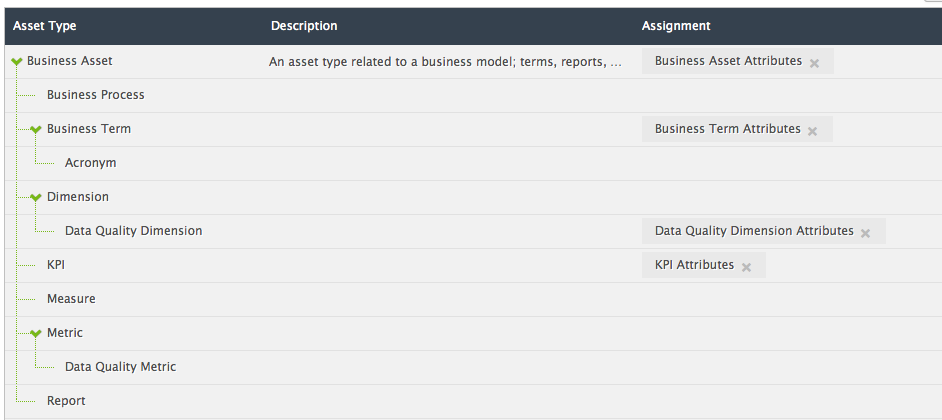
Business assets can be grouped by two Domain Types, i.e. “Business Asset Domain” and “Glossary“.
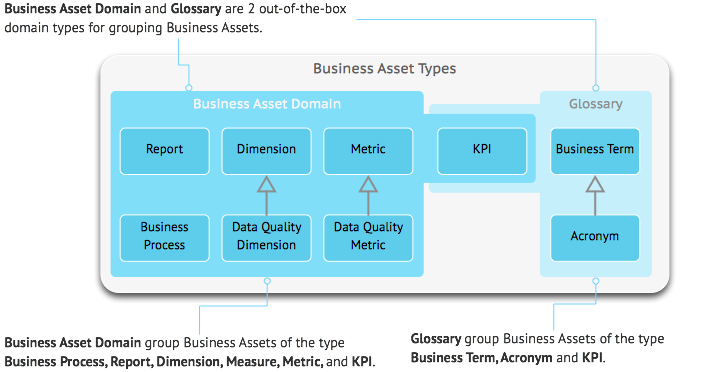
What is a Business Term?
Definition and Example
[bok-callout]Definition
A Business Term is a word or phrase that is used to describe or express a concept in a particular kind of language or branch of business.[/bok-callout]
The following screenshot shows the page of an example Business Term “Customer”. It shows the attributes Definition, Criticality Level, Security Classification, and Description. Moreover, it shows the relations with other Assets: Represented By and System of Record. Note that textual attributes (see e.g., Description) may contain hyperlinked (blue and underlined) words, indicating that word also is used for the name of another asset.

Business Term Template
The diagram below visualises the template for Business Term, i.e. overviewing all its Attribute Types and Relation Types.
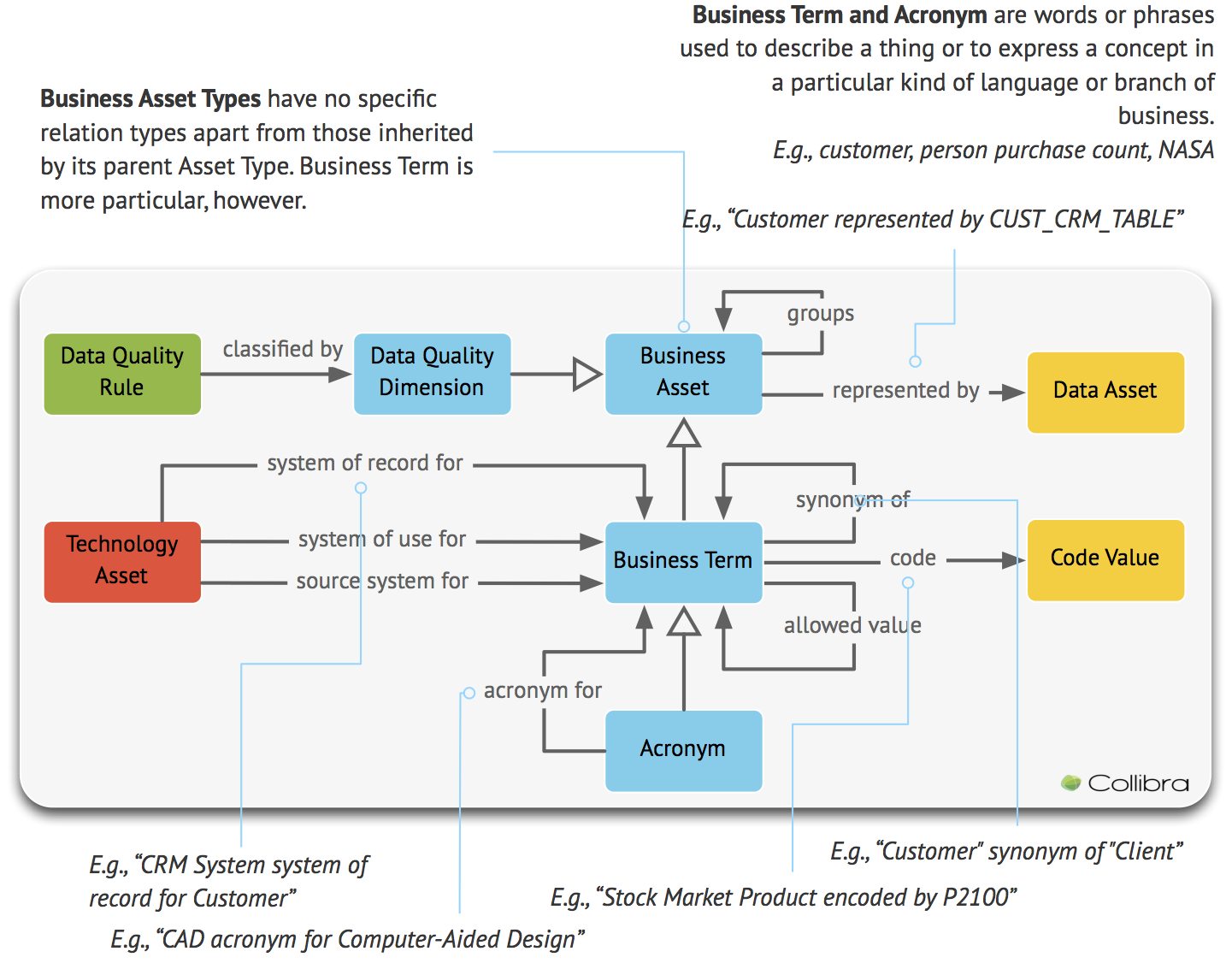
The above example for Business Term “Customer” is stored as follows.

Business Term Attributes
A Business Term has the following two mandatory Attributes :
- exactly one Definition that provides a phrase to define it clearly and unambiguously: e.g., “a Person or organization that placed at least one order for at least one product with our organization and parent organizations”.
- one or more Descriptions that provides a longer definition: “A Customer (also know as a Client, buyer or purchaser) is usually used to refer to a current or potential buyer or user of the Product of an individual or Organization, called the supplier, seller, or vendor. This is typically through purchasing or renting goods or services.”
A Business Term has the following three optional Attributes:
- at most one Criticality Level: you can choose from the following out-of-the-box values: Basel III Critical, SOX Critical, Business Critical.
- at most one Security Classification: you can choose from the following out-of-the-box values: Confidential, Protected, Restricted, Unrestricted.
- zero or more Notes that are pieces of free text to share non-essential information but contributes to the specification of the Business Term.
Business Term Relations
A Business Term may have the following Relations with Data Assets :
- (is) Represented by: Data Assets (such as Data Columns and Data Models) that provide a logical representation for the Business Term. (inherited from Business Asset Type).
- (has) Code: Code Value that provides a valid – shortened or covert – form or representation for a Business Term that substitutes a longer one. E.g., “P1000 ” is a Code Value enumerated in the Enterprise Product Code to refer to a “convertible bond”.
The two examples is depicted by the diagram below.

Business Terms may have the following Relations with Technology Assets :
- (has) System of Record: Technology Assets (such as Databases or Systems ) that provide physical recording of instances of the Business Term .
- (has) System of use: Technology Assets (such as Databases or Systems ) that use the definition of a Business Term .
- (has) Source System: Technology Assets (such as Databases or Systems ) that provide a source for the Business Term .
These three Relation types have a similar meaning. The choice depends on how your own organisation prefers to express them. These examples are depicted in the diagram below.
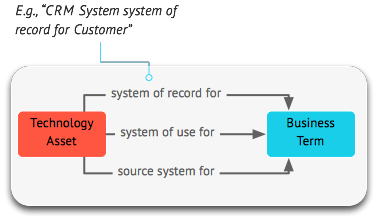
Finally, Business Terms may have the following Relations with Business Assets:
- (has) Acronym: See section What is an Acronym?
- (has) Synonym: other Business Term(s) in the same or another domain that have the same meaning. E.g., “client” may be a synonym for “customer”.
- (has) Allowed Value / (is) Allowed Value For: E.g., Business Term USA may an allowed value for Business Term Country.
- Groups / (is) Grouped By: with other Business Assets (such as Business Processes, KPIs, Measures, etc.)
- zero or more KPIs Are Calculated Based on Metrics: a complex relation.
Business Term Traceability
These relations can provide traceability as illustrated below in the Traceability Diagram.
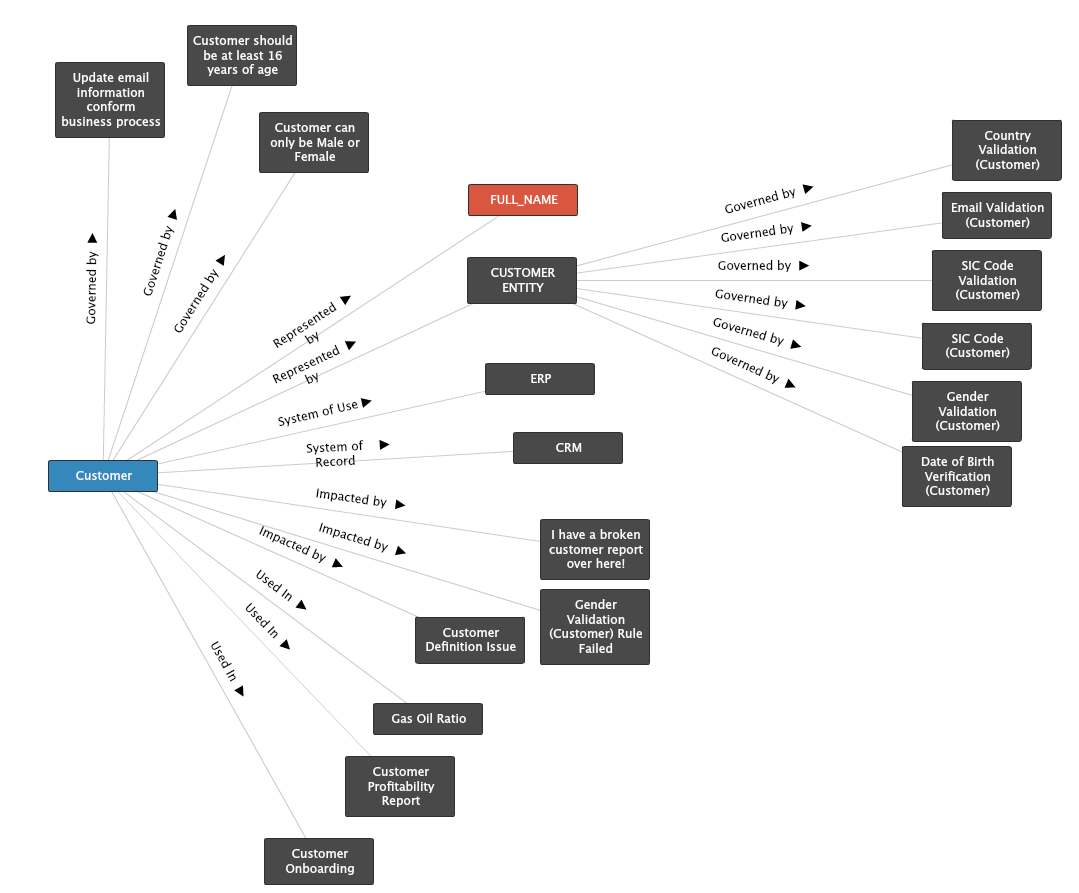
What is an Acronym?
Definition and Example
A Business Term is usually expressed by a noun such as “Customer” or “Revenue per Customer”.
[bok-callout type=”noicon”]Definition
An Acronym is a special type of Business Term. It is an abbreviation formed from the initial letters of other words and pronounced as a word: e.g., “NASDAQ”.[/bok-callout]
In the following example the Acronym “RPC” is acronym for Business Term “Revenue per Customer”.

Acronym Template
The diagram below illustrates how this relation between Business Terms and Acronyms is stored in DGC.

Acronym Traceability
In the Traceability Diagram it looks as follows.
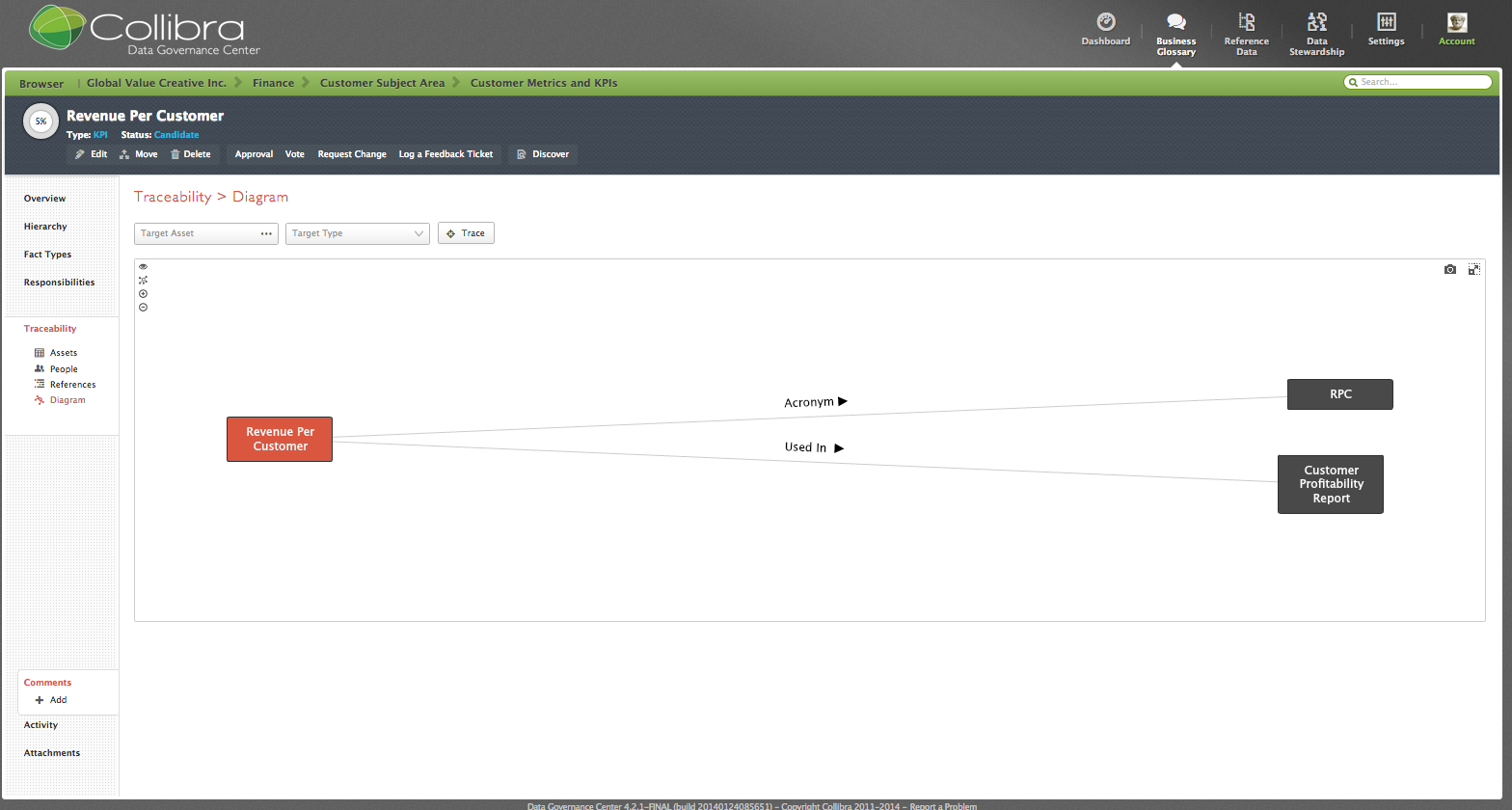
What is a KPI?
Definition and Example
[bok-callout type=”noicon”]Definition
A KPI is a key performance indicator. It is a special Business Asset Type. [/bok-callout]
Consider the example of “Revenue Per Customer”. It has a definition and a unit of measure.
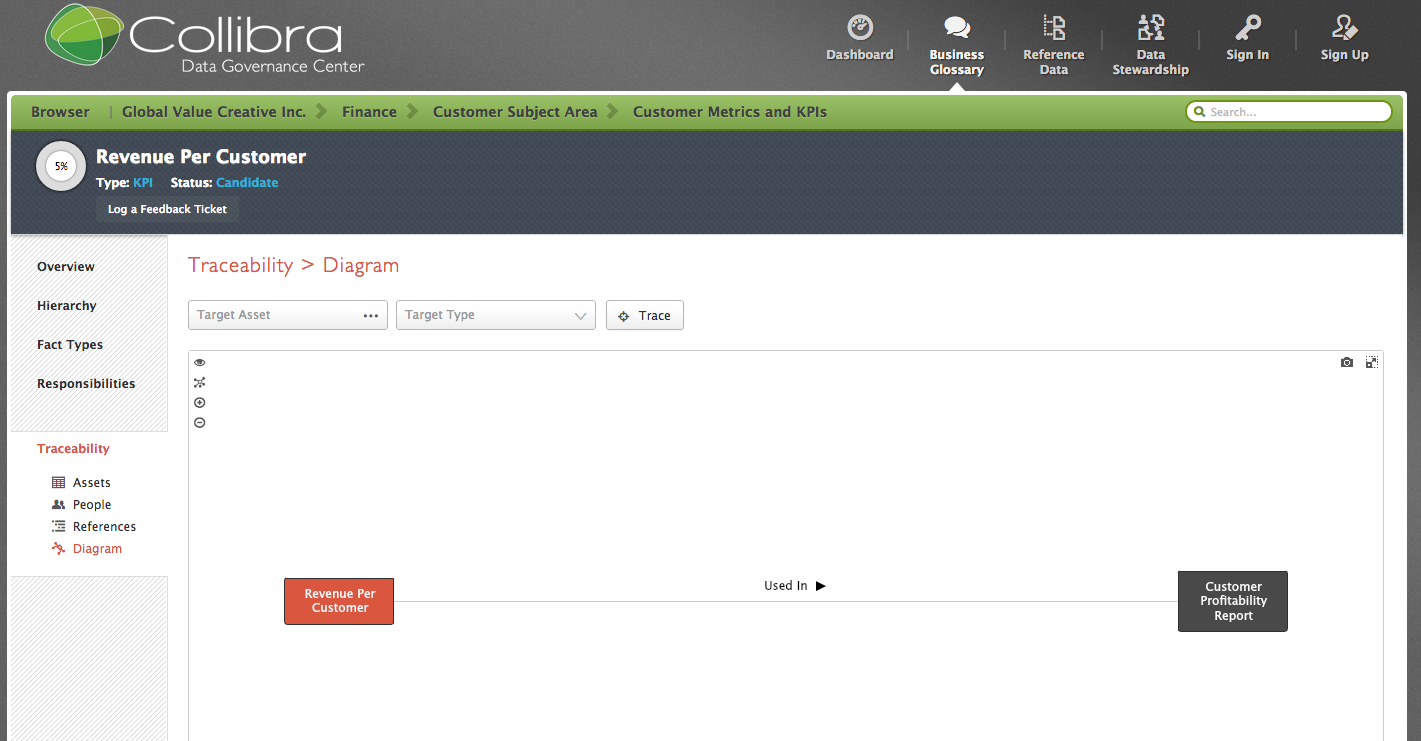
You have to login to comment.

